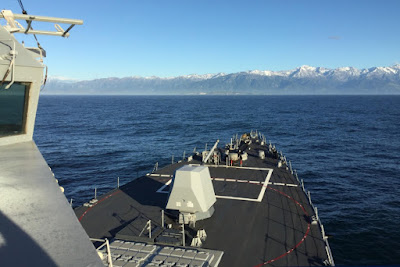 According to Mark Greaney (and the late but immortal Tom Clancy) President Jack Ryan leads the free world in 2017 – as ISIS works through a rogue Saudi, Yemeni and Romanian to allow Islamist militants to target, attack and kill hundreds of Americans in cities across the United States.
According to Mark Greaney (and the late but immortal Tom Clancy) President Jack Ryan leads the free world in 2017 – as ISIS works through a rogue Saudi, Yemeni and Romanian to allow Islamist militants to target, attack and kill hundreds of Americans in cities across the United States.The remedy: Arm every off duty service member with military-issued concealed handguns but resist the urge to invade another Middle East country. Also, beef up cyberdefense. Finally, while under attack, keep your cool even in the face of threats to the Constitution and the very existence of the nation.
According to Greaney, speaking through President Ryan in his novel "True Faith and Allegiance" (Putnam, 2016), "People have a reasonable tendency to do one of two things when they listen to someone in government warn them of a threat. They either tune in or freak out."
It's the voice of reason from the fictional commander-in-chief – channeling Peter Bergen. Here's the wisdom of Clancy's and Greany's speaking through their President Ryan:
"Let's keep this in perspective for the average U.S. citizen. It is a sad fact that there were more than fifty shootings in Chicago over the weekend, with seven dead. There exists, quite unfortunately, violence all around us. What is happening with these Islamic State terrorists in our borders is of utmost concern to us, but I would not want the average American citizen to do anything more than report any concerns you may have to your local law enforcement agency."The president watches as his son Jack Ryan Jr. and his team of quasi-official operatives save the world. No spoiler alert needed.
 |
| Tom Clancy gets a brief aboard a UH-60 Black Hawk in 2002. (Photo by Tech. Sgt. Mark C. Olsen) |
The premise is drawn in part from real-life events in June 2016 when hackers stole personal private information about millions of people from the Office of Personnel Management.
Cybercrime + open source intelligence x cyberwarfare = terror.
 |
| USS Sampson (DDG 102) operates off the coast of Kaikoura, New Zealand in November 2016. |
Working with more than forty characters, Greaney never loses the pace, balance or intrigue moving from narrative and dialog, including in White House press conferences, to then unleash the action. And, unlike some other thrillers, there's only a minimal amount of eye-rolling to some pretty unrealistic situations.
For example: The story opens at a Mexican restaurant in New Jersey with a harrowing and seemingly disconnected attack on Cmdr. Scott Hagen, captain of USS James Greer (DDG-102) by a crazed Russian avenging the death of his brother in a Baltic sea battle. (The real DDG-102, by the way, is USS Sampson, homeported in San Diego. Sampson recently assisted New Zealand after an earthquake.)
Iranians, North Koreans, Chinese, Eastern Europeans and various spies of all persuasions make appearances, as do the Peshmerga and their friends.
 |
| U.S. Army AH-64E Apache helicopters (Photo by Capt. Brian Harris). |
Intended irony? Both the protagonists and evildoers in this thriller are fired up by a desire for "righteous payback."
Fortunately, President Jack Ryan (played in the past by Alec Baldwin, Harrison Ford, Ben Affleck and Chris Pine and reportedly to be played by John Krasinski fighting ISIS/ISIL in an Amazon TV series) is a voice of relative reason in a dynamic and dangerous world waiting for the better angels of our nature.

MEDITERRANEAN SEA (June 15, 2016) Aircraft carrier USS Harry S. Truman (CVN 75) conducts flight operations in the Mediterranean Sea. Harry S. Truman Carrier Strike Group is deployed in support of Operation Inherent Resolve, maritime security operations and theater security cooperation efforts in the U.S. 6th Fleet area of operations. (U.S. Navy photo by Mass Communication 3rd Class J. M. Tolbert/Released)













